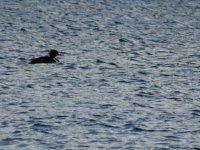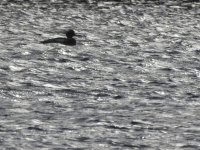On the 19th, I saw what I took to be a Goosander on my local patch/loch. First that I have seen on the water in 5 or 6 years of birding here, but they have been reported by others on the odd occasion. Bird was at distance, and in very poor light conditions, but the white chin, and apparently pale breast had me convinced that this (photo 1) was a Goosander.
Today, in almost the exact same position, again at distance, but this time shooting into the sun, I saw the familiar shape of a Merganser, but looking at the photos at home, I am thinking Red-breasted (see photo 2). Dark looking breast and wing pattern seem to support my ID. The loch is less than a mile from the Firth of Forth, where I regularly see R-BMs, however, in 5 to 6 years, I've never seen or heard of one on the loch.
I think it is the unlikelihood of getting both of these species in such a short period of time, on a water where they are rarely seen, that has sowed seeds of doubt in my mind.
Thoughts please, and apologies for the poor quality of the record shots.
Today, in almost the exact same position, again at distance, but this time shooting into the sun, I saw the familiar shape of a Merganser, but looking at the photos at home, I am thinking Red-breasted (see photo 2). Dark looking breast and wing pattern seem to support my ID. The loch is less than a mile from the Firth of Forth, where I regularly see R-BMs, however, in 5 to 6 years, I've never seen or heard of one on the loch.
I think it is the unlikelihood of getting both of these species in such a short period of time, on a water where they are rarely seen, that has sowed seeds of doubt in my mind.
Thoughts please, and apologies for the poor quality of the record shots.






